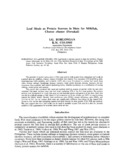Potential of feed pea (Pisum sativum) meal as a protein source in practical diets for milkfish (Chanos chanos Forsskal)
- Global styles
- MLA
- Vancouver
- Elsevier - Harvard
- APA
- Help

View/
Date
2003Page views
4,830ASFA keyword
AGROVOC keyword
Taxonomic term
Metadata
Show full item record
Share
Abstract
A 12-week feeding trial was conducted to evaluate the use of feed pea meal as a dietary protein source for juvenile milkfish. Six isonitrogenous (30% crude protein) and isocaloric (16.5 kJ/g) practical diets were formulated. The control diet contained fish meal, soybean meal, meat and bone meal and copra meal as principal protein sources. Feed pea meal was progressively substituted at 0%, 5%, 10%, 15%, 20%, 25% and 30% of total protein. A leading commercial milkfish feed was also tested as an additional control. The experimental diets were fed to triplicate groups of milkfish fingerlings (mean initial weight of 0.42±0.01 g) at 10% body weight/day. Growth performance (expressed as percentage of weight gain and SGR), survival, feed conversion ratio (FCR) and protein efficiency ratio (PER) of milkfish fed diets with up to 10% substitution of the dietary protein with feed pea meal were not significantly different (P>0.05) compared to fish fed the control diet. Replacement with feed pea meal at 15% and higher levels led to milkfish fed these diets showing a significantly lower growth response compared to fish fed with the control without any feed pea meal. Nevertheless, it was observed that milkfish fed diets with up to 20% of total dietary protein substitution with feed pea meal showed better growth rates and feed conversion ratios than the commercial feed control. Whole body composition (crude protein, crude fat, crude fiber, nitrogen-free extracts and ash content) of milkfish fed the various test diets was not significantly different. Apparent digestibility coefficients of feed pea meal and experimental diets in milkfish were also determined. Results indicate that feed pea meal is an acceptable protein source and can replace up to 20% of the total dietary protein in milkfish diets.
Keywords
Aquaculture feeds Alternative protein source Feed pea (Pisum sativum) Meal Milkfish (Chanos chanos Forsskal)Suggested Citation
Borlongan, I. G., Eusebio, P. S., & Welsh, T. (2003). Potential of feed pea (Pisum sativum) meal as a protein source in practical diets for milkfish (Chanos chanos Forsskal). Aquaculture , 225(1-4), 89-98. https://doi.org/10.1016/S0044-8486(03)00280-1
Type
ArticleISSN
0044-8486Collections
- Journal Articles [1258]
Related items
Showing items related by title, author, creator and subject.
-
Utilization of feed pea, Pisum sativum, meal as protein source in practical diets for juvenile shrimp, Penaeus monodon
Bautista-Teruel, Myrna N.; Eusebio, Perla S.; Welsh, Timothy P. (Elsevier, 2003)The potential of feed pea meal as an alternative protein source to soybean meal in practical diets for the juvenile tiger shrimp, Penaeus monodon, was assessed in several experiments. Six isonitrogenous diets were formulated ... -
Requirements of juvenile milkfish (Chanos chanos Forsskal) for essential amino acids
Borlongan, Ilda G.; Coloso, Relicardo M. (American Society for Nutrition, 1993)The dietary requirements of juvenile milkfish (Chanos chanos Forsskal) for essential amino acids were determined in a series of experiments. The fish (< or = 8.0 g) were reared in fiber glass tanks provided with flow-through ... -
Leaf meals as protein sources in diets for milkfish Chanos chanos (Forsskal)
Borlongan, I. G.; Coloso, R. M. (Asian Fisheries Society, 1994)The protencial of partial replacement of fish meal protein with protein indigenous leaf meals in practical diets for milkfish, Chanos chanos (Forsskal) was studied. Five isocaloric (375 kcal/100 g diet), isonitrogenous ...





